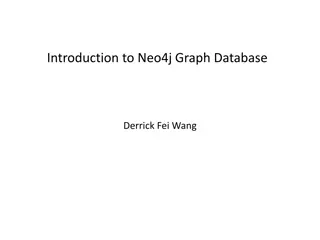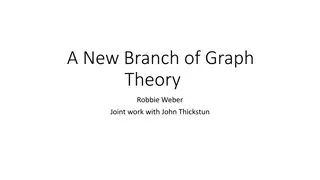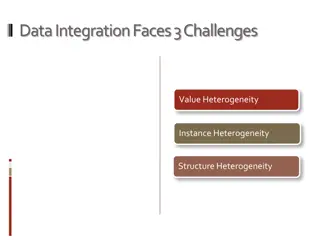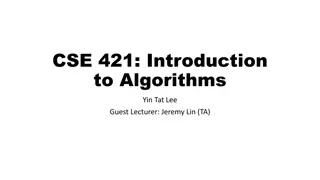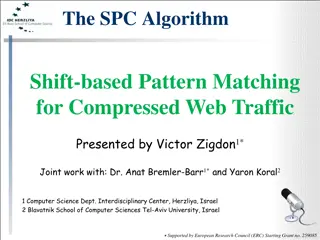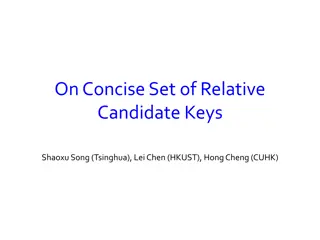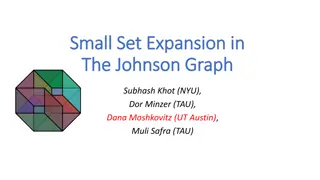Graph Pattern Matching Challenges and Solutions
Graph pattern matching in social networks presents challenges such as costly queries, excessive results, and query focus issues. The complexity of top-k and diversified pattern matching problems requires heuristic algorithms for efficient solutions. Finding best candidates for project roles involves defining specific patterns and using graph simulation for matching. The goal is to find diversified top-K matches for graph pattern matching with designated output nodes.
Download Presentation

Please find below an Image/Link to download the presentation.
The content on the website is provided AS IS for your information and personal use only. It may not be sold, licensed, or shared on other websites without obtaining consent from the author.If you encounter any issues during the download, it is possible that the publisher has removed the file from their server.
You are allowed to download the files provided on this website for personal or commercial use, subject to the condition that they are used lawfully. All files are the property of their respective owners.
The content on the website is provided AS IS for your information and personal use only. It may not be sold, licensed, or shared on other websites without obtaining consent from the author.
E N D
Presentation Transcript
Diversified Top-k Graph Pattern Matching Wenfei Fan University of Edinburgh Xin Wang Xin Wang Yinghui Wu UC Santa Barbara Southwest Jiaotong University 1
Graph pattern matching in social search Graph pattern matching in social networks Applications: social relationship search, social role analysis, expert search, etc. Social graphs are typically large, with billions of nodes and edges. Challenges Costly over large social networks; Matching algorithms return too many results; query focus in social network queries These motivate us to find best matches of the specific pattern node via graph pattern matching. However the problems are challenging! 2
Hardness of the problems Top-k graph pattern matching problem Complexity: O(|G||Q| + |G|2) time with early termination. Diversified top-k graph pattern matching problem Complexity: NP-complete; 2-approximable in O((|Q||G|+|V|(|V|+|E|)) time; Early termination heuristic algorithm in O((|Q||G|+|V|(|V|+|E|)) time. Approximating Diversification 2-approximable algorithm Idea: rounding down diversification function and reduce to Maximum dispersion. Early termination heuristics Idea: greedily select new matches that maximizes the difference with selected matches. 3
Finding best candidates complete matching relation (project manager, PM1), (project manager, PM2) (project manager, PM3), (project manager, PM4) (programmer, PRG1), (programmer, PRG2) (programmer, PRG3), (programmer, PRG4) (DBmanager, DB1), (DBmanager, DB2) (DBmanager, DB3) (tester, ST1), (tester, ST2) (tester, ST3), (tester, ST4) Query: find good PM (project manager) candidates collaborated with PRG (programmer), DB (database developer) and ST (software tester). When graph pattern matching is defined in terms of subgraph Isomorphism, no match of Q can be identified in G, since it is too restrictive to define matches as isomorphic subgraphs. We adopt to find matches using graph simulation, which computes a binary relation on the pattern nodes in Q and their matches in G. Project Manager* query focus PM1 PM2 PM3 PM4 DB manager Programmer PRG1 DB1 PRG4 DB2 PRG3 DB3 BA Tester Pattern graph Q UD1 ST1 ST2 ST3 UD2 PRG2 ST4 Collaboration network G 4
Problem formalization Graph pattern matching using simulation (VLDB 10) a graph G matches a pattern P if there exists a matching relation S; for each pair (u, v) in S, v is a node in G that matches u in P; for each edge (u, u ) in P, there exists an edge (v, v ) in G and (u , v ) is in S. Project Manager* (PM1-PM4) in the example Graph pattern matching revised extend a pattern with a designated output node u0 matches Q(G): the matches of u0 readily extends to multiple output nodes DB manager Programmer Tester Problem: we want to find (diversified) top-K matches for graph pattern matching with a designated output node. 5
Top-k matching problem Relevance Relevant set R(u,v) for a match v of a query node u: all descendants of v as matches of descendants of u a unique, maximum relevance set Relevance function The more reachable matches, the better PM2 PRG4 DB2 PRG3 DB3 ST2 ST3 PRG2 ST4 Top-k matching: find top-k match set that maximizes total relevance 6
Match Diversification Match diversity Diversity function: set difference of the relevant set Diversification: a bi-criteria combination of both relevance and diversity relevance: common neighbors, Jaccard coefficient diversity: neighborhood diversity, distance-based diversity Diversified Top-k Matching: find a set S of matches for output node s.t 7
Finding Top-k Matches (for Acyclic Patterns) Finding Top-k matches for acyclic patterns Initializes a heap S, and a vector for each candidate v Xv: match? v.R: relevance set v.lower, v.upper: relevance bound Computes a set of matches for some query nodes (can be determined without following steps) Iteratively updates vectors of other candidates by propagating the partial answers Termination condition: (1) each v in S is a match of uo, and (2) minv S(l(uo, v)) maxv can(uo)\S(h(uo, v)), where l(uo, v) and h(uo, v) denote a lower bound and upper bound of r(uo, v). 8
Finding Top-k Matches (for Acyclic Patterns) PM1 PM2 PM3 PM4 Project Manager* PRG1 DB1 PRG4 DB2 PRG3 DB3 BA Starting propagation from DB2, after Programmer After initialization, vectors of parts nodes. propagation, parts of the vectors are as below. DB manager UD1 ST1 ST2 ST3 UD2 PRG2 ST4 v v.T = <v.bf, v.R, v.l, v.h> v v.T = <v.bf, v.R, v.l, v.h> <XPM1 = XPRG1 XDB1, , 0, 2> <XPM2 = ((XPRG3 =true) V (XPRG4=true)) XDB2=true, {DB2, PRG4, PRG3}, 3, 3> <XPM3 = (XPRG3 = true) (XDB2=true), {DB2, PRG3}, 2, 2> <XPM4 = (XPRG3 = true) XDB3, , 0, 2> <XPRG1 = XDB1, , 0, 1> <XPRGj = true, {DB2}, 1, 1> <XDB2 = true, , 0, 0> PM1 <XPM1 = XPRG1 XDB1, , 0, 2> <XPM2 = (XPRG3 V XPRG4) XDB2, , 0, 3> <XPM3 = XPRG3 XDB2, , 0, 2> <XPM4 = XPRG3 XDB3, , 0, 2> <XPRG1 = XDB1, , 0, 1> PRGj (j [3,4]) <XPRGj = XDB2, , 0, 1> DBk (k [1,3]) <XDBk = true, , 0, 0> DBk (k [1,3]) <XDBk = true, , 0, 0> PM1 PM2 PM2 PM3 PM2 is verified to be a valid match, and its relevant set includes {DB2, PRG4, PRG3}, which is the largest relevant set compared with other PMs. Early termination condition is met. PM3 PM4 PM4 PRG1 PRG1 PRGj (j [3,4]) DB2 9
Finding Top-k Matches (for Cyclic Patterns) Finding Top-k matches for cyclic patterns Computes topological rank r(u) of query nodes u in Q; Iteratively updates vectors of candidates by propagating the partial answers if the corresponding uscc contains only one node; Otherwise, employs Procedure SccProcess to verify matches. Project Manager* Project Manager* r(PM) = 2 r(uscc) = 1 DB manager Programmer DB manager Programmer Tester r(ST) = 0 Tester 10
Finding Top-k Matches (for Cyclic Patterns) PM1 PM2 PM3 PM4 Project Manager* PRG1 DB1 PRG4 DB2 PRG3 DB3 BA DB manager Programmer Tester UD1 ST1 ST2 ST3 UD2 PRG2 ST4 Start propagation from ST3 and ST4 v v.T = <v.bf, v.R, v.l, v.h> <XPM1 = XPRG1 XDB1>, , 0, 4> PM1 <XPM2 = (XPRG3 V XPRG4) XDB2, , 0, 8> PM2 XPM2=true XPM3=true XPM3=true PM2 and PM3 are top-2 matches, since we can determine their relevance sets are largest two sets. <XPM3 = (XPRG3 XDB2), , 0, 6> PM3 <XPM4 = (XPRG3 XDB3), , 0, 6> PM4 <XPRG1 = XDB3 true, , 0, 6> XPRG2=true PRG2 The algorithm can terminate early, although PM2 has another descendant ST2 which is also a true match of ST and PM1 is not verified at all. <XPRG1 = XDB2 true, , 0, 6> PRG3 XPRG3=true <XPRG4 = XDB2 true, , 0, 7> PRG4 XPRG4=true <XDB2 = XPRG2 true, , 0, 6> XDB2=true DB2 <XDB3 = XPRG3 true, , 0, 6> XDB3=true DB3 11
Finding Top-k Diversified Matches r () V R(uo, v) d () PM1 PM2 PM3 PM4 PM1 {PRG1, DB1, ST1, ST2} 4 PM1 0 10/11 1 1 PM2 {PRG4, PRG3, PRG2, DB2, DB3, ST2, ST3, ST4} 8 PM2 10/11 0 1/4 1/4 PM3 {PRG3, PRG2, DB2, DB3, ST3, ST4} 6 PM3 1 1/4 0 0 PM4 {PRG3, PRG2, DB2, DB3, ST3, ST4} 6 PM4 1 1/4 0 0 PM1 and PM3 are picked by TopKDiv as top-2 diversified matches. PM1 PM3 F() PM1 PM2 PM3 PM4 PRG3 PM1 1.45 1.45 1.45 PRG1 DB1 DB2 DB3 PM2 1.45 0.89 0.89 PM3 1.45 0.89 0.55 PM4 1.45 0.89 0.55 F (PM1, PM3)=0.5*(4/11+6/11) + 1 = 1.45 ST1 ST2 ST3 PRG2 ST4 PM1 and PM3 have no descendant matches in common, and influence a large part of the matches. 12
Finding Top-k Diversified Matches PM1 PM2 PM3 PM4 PRG1 DB1 PRG4 DB2 PRG3 DB3 BA UD1 ST1 ST2 ST3 UD2 PRG2 ST4 PM2 and PM3 are picked by TopKDH as top-2 diversified matches. PM2,PM3,PM4 are verified true matches, and the termination condition is satisfied. v v.T = <v.bf, v.R, v.l, v.h> <XPM1 = XPRG1 XDB1>, , 0, 4> PM1 <XPM2 = (XPRG3 V XPRG4) XDB2, {PRG4, PRG3, PRG2, DB2, DB3, ST3, ST4} , 7, 8> PM2 <XPM3 = (XPRG3 XDB2), {PRG3, PRG2, DB2, DB3, ST3, ST4}, 6, 6> PM3 <XPM4 = (XPRG3 XDB3), {PRG3, PRG2, DB2, DB3, ST3, ST4}, 6, 6> PM4 F (PM2, PM3)=(1-0.1) * (7/11+6/11) + 2*0.1*/(2-1) * 1/7 = 1.1 13
Experimental evaluation Dataset Real-life graphs Graphs |V| |E| Amazon co-purchasing network 548,552 1,788,725 Citation 1,397,240 3,021,489 Youtube 1,609,969 4,509,826 Synthetic graphs Amazon EC2 Instance with 3.75GB memory, 2 EC2 compute unit. Algorithms Top-k matching (with/without optimization) Brute force algorithm Diversified algorithm: Approximation & Heuristic with early termination 14
Experimental evaluation Varying |Q| on Youtube 15
Experimental evaluation Varying |Q| on Amazon Varying |Q| on Youtube 16
Conclusion && Future work Conclusion revised graph patterns by supporting a designated output node; defined functions to measure match relevance and diversity, as well as a bi-criteria objective function based on both; algorithms for computing top-k matches, and for finding diversified top-k matches, with properties such as constant approximation ratios and early termination; verified effectiveness of our methods. Future work Optimization techniques to further reduce the number of matches examined by our algorithms; Distributed top-k matching algorithms on graphs that are partitioned, distributed and possibly compressed. 18
Thanks! 19





